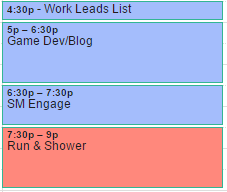Game development is a marathon. It’s a long, difficult endeavor that eliminates the unprepared by sapping their endurance a quarter-mile at a time. It takes at least a year, at the bare minimum, to take a board game idea and turn into a ready-to-sell product. Anything less than that is next to impossible, and 18-24 months is a lot more realistic.
Looking for more resources to help you on your board game design journey?
Here you go: no email required!
Like this writing style?
Check out my latest blog on marketing here.
Staying organized and managing your time well are critical to self-publishing a game. There are a lot of things to do, a lot of things to track, and a lot of time that needs to be spent. You need to keep your digital and physical files organized, you need to keep a to-do list, you need to keep a project timeline, and you need to make and stick to a calendar. If you do not stay organized, you’ll be pulled in too many different directions and you won’t get hardly anything done.
Let’s start from the top down. I’ll talk about big time-frames and how you can organize your time and your efforts in the long-term and we’ll slowly work our way down to from years to minutes.

Years
Accept that it takes at least a year to make a game, and often 18-24 months. It almost always takes more than one game to make a good amount of money. By self-publishing, you’re starting a business and that most businesses need 3-5 years to make a decent amount of money.
Years are too big of a time frame to meaningfully organize your activities around, but it’s important to accept the long arc of what you’re getting into. Lots of people make games. Most people quit. You don’t have to be one of them. I feel like the main differences between the quitters and the winners are expectations, passion, and willingness to improve.
Months
Game development as a process falls into several stages, most of which take months. They include…
Early Production
Game design and development. This is the process by which game ideas are crafted into working products. This usually takes at least 6 months. Making the game work isn’t necessarily the hard part. The hard parts are play testing it, getting artwork, and getting the whole product ready for the market.
Artwork. You get someone to do the art for your game. Unless you’re really talented, you shouldn’t do art for your own game. The amount of time this takes is dependent upon your artist’s schedule and the complexity of your game, but even a simple board game could take around 4 months.
Production. You’ll need to print some sample copies of your game to make sure all your ideas translate well to a physical product. This could take a month or more. It could take much, much longer if you wind up having to make changes.

Reviews. Before you can launch a Kickstarter, you’ll need reviews for people to take you seriously. Reviewers tend to drag their feet, so you should account for two months between sending them a copy and them writing a review. You also need to account for the time it takes to produce sample copies. Budget 3 months for this.
Kickstarter. While most Kickstarters are around a month in length, the preparation before and the clean-up afterward take another month together. You should plan to spend about 2 months on Kickstarter. This is assuming, of course, that you succeed. About half of Kickstarters in the board game market don’t. If you fail, you’ll need to relaunch and that involves more time. Also, if you want to succeed in the first place, you’ll need to have a community built up from several months prior as well.
Late Production
Manufacturing. It takes about a month to print board games. Then it takes about three months to ship them by sea. Yes, you read that right. You can air ship them, but it’s really expensive and I can’t recommend that you do that in good faith. Plan for 4 months to manufacture assuming everything goes well. Manufacturing delays in addition to that 4 month time frame are very common.
Fulfillment. Whether you ship your games yourself or with the help of third parties, it’s going to take a bare minimum of two weeks to get everything in the mail. Plus you’ll be intermittently solving problems related to fulfillment in the months to come.
Sales. This can go on for as long as your game has a community! Here is the thing, though: this never really ends.
Marketing. Even if you had a game perfectly ready to go, you’d still need to build a community through wise marketing and promotion practices for at least six months, but realistically closer to a year to make even a modest amount of money on Kickstarter.
How do you keep track of all of this? One such way is to create a Gantt chart, shown below. Each different stage can be imagined as a row. The columns represent time. This helps you get a feel for how your game’s creation process will work. If you get ahead or fall behind, you can tweak the bars to be shorter or longer and move everything else that comes along with it. I made this chart in Excel, but there are better programs for it.

Weeks
Every week, it’s a good idea to set goals. Sure, you can have broader goals of “be a good game dev” and “make this game a real thing.” In fact, those are really important to have! But with weekly goals, your focus should be making them specific and achievable. Line up your weekly goals with your broader goals.
I like keeping my weekly goals in Evernote. I set weekly goals every Saturday and I track certain metrics like web traffic, followers, newsletter subscribers, and sales that I think line up with my bigger goals. Here’s what my weekly goals look like right now.

Days
On a day-to-day basis, you want to make sure you have time to actually achieve what’s on your weekly goals. After all, it’s the weekly goals that link up to the monthly stages of board game development and the multi-year epic journey that is getting published. I suggest using Google Calendar to track your time in 30 minute blocks. You can move these blocks around as you like, but the idea is to actually set aside time every day to work on your goals.

Hours
When it comes to setting up time for making a game, it’s not just about putting in long hours. Sure, you might have to put in long hours, but the reality is that you don’t have to put that much time in everyday to make it. You just have to put a good amount of time in most days for a few years.
Make your time count. Only spend time on what’s worthwhile. Try to schedule tasks when your mind and body are capable of doing them well. Always look for ways to improve your processes. If you can outsource work, do it. If you can automate work, do it. Work smart so that when you work hard, it’s worth the extra oomph!
Minutes
Focus is critical. Find out what distracts you. Is it social media? The constant buzzing of text messages? Are your kids interrupting you? Is it noisy neighbors? Figure out what triggers distraction in you. Seek to eliminate or reduce distraction wherever you can so you don’t get your precious little minutes stolen.
Mindful use of your time is key to success in game development and self-publishing. Set realistic expectations. Have an understanding of what it takes to get from point A to point B. Set clear goals. Keep a schedule. Block off time. Reduce distractions. Improve processes.
You do this and you’re one step away from Start and one more step toward Finish.
Time is Only Half of the Problem, Energy is the Other Half
I originally wrote this blog post in early 2017. The tips I’ve talked about here have helped me to survive a failed Kickstarter campaign, launch a successful one, and start a marketing agency.
I used this advice every day while I took care of an injured family member and even as the coronavirus pandemic took hold of the world. To this day, I still use Google Calendar, although I’ve given up Evernote for a more visual Trello board.
I want it to be crystal clear that I practice what I preach, because I need you to understand that time management is half the battle. Energy management is the other half. I talk about that at length in this post. To save you a click, though, here are the basic principles:
- Figure out when you’re most likely to be in a creative, analytical, and social mood.
- Plan your day around when you typically experience these moods.
- Always leave some flexibility in your workload so you can switch tasks if you get stuck.
If you can combine these energy management tips with time management skills, I earnestly believe that it will help you to achieve your goals.





7 thoughts on “How to Master Time (So You Can Make Games)”
“Reviews. Before you can launch a Kickstarter, you’ll need reviews for people to take you seriously. ”
I’ve found this to be confounding. I’ve made some great looking prototypes, but have made absolutely no progress in getting anyone to agree to review (or even walkthrough) the game.
In fact, in speaking with Jon from Jon Gets Games, he was very sympathetic, but told me that he basically has no advice in order to get reviewed by anyone with viewership, because they need to review retail-ready games for their audience to keep interest.
This, coupled with what seems to be no progress in building a “crowd”, have been huge challenges for us. The game design, art, and prototyping process is a lot of fun, I wish we could get over these hurdles.
Hi Josh, thank you for commenting!
You’re right that this is confounding. You retail-ready games for review, but you need review for retail-ready games. It’s a classic catch-22.
The most effective way I’ve found to move forward is to make the most professional prototype you can with materials from sites like Board Games Maker and The Games Crafter and find smaller reviewers in your niche.
As for building a crowd, this is a major hurdle as well. Even having an audience doesn’t guarantee success, but lacking one nearly ensures failure. Setting up a simple website and social media is a great place to start. You can also try working your way into Facebook groups, Board Game Geek sub-communities, subreddits, and so on. No matter what you do, though, building an audience is at least a six-month process.
A couple years ago I invented a board game based on a very popular new sport called Pickle Ball. I think the game is very innovative and creative and if developed properly would attract a lot of attention. I need to talk to the right people. I have developed a video presentation which shows the board game and how it is played.
Great advice and stage infographic, thank you!
Great article, thank you for the advice. Has really helped me at the very beginning to start going and have the project organised.